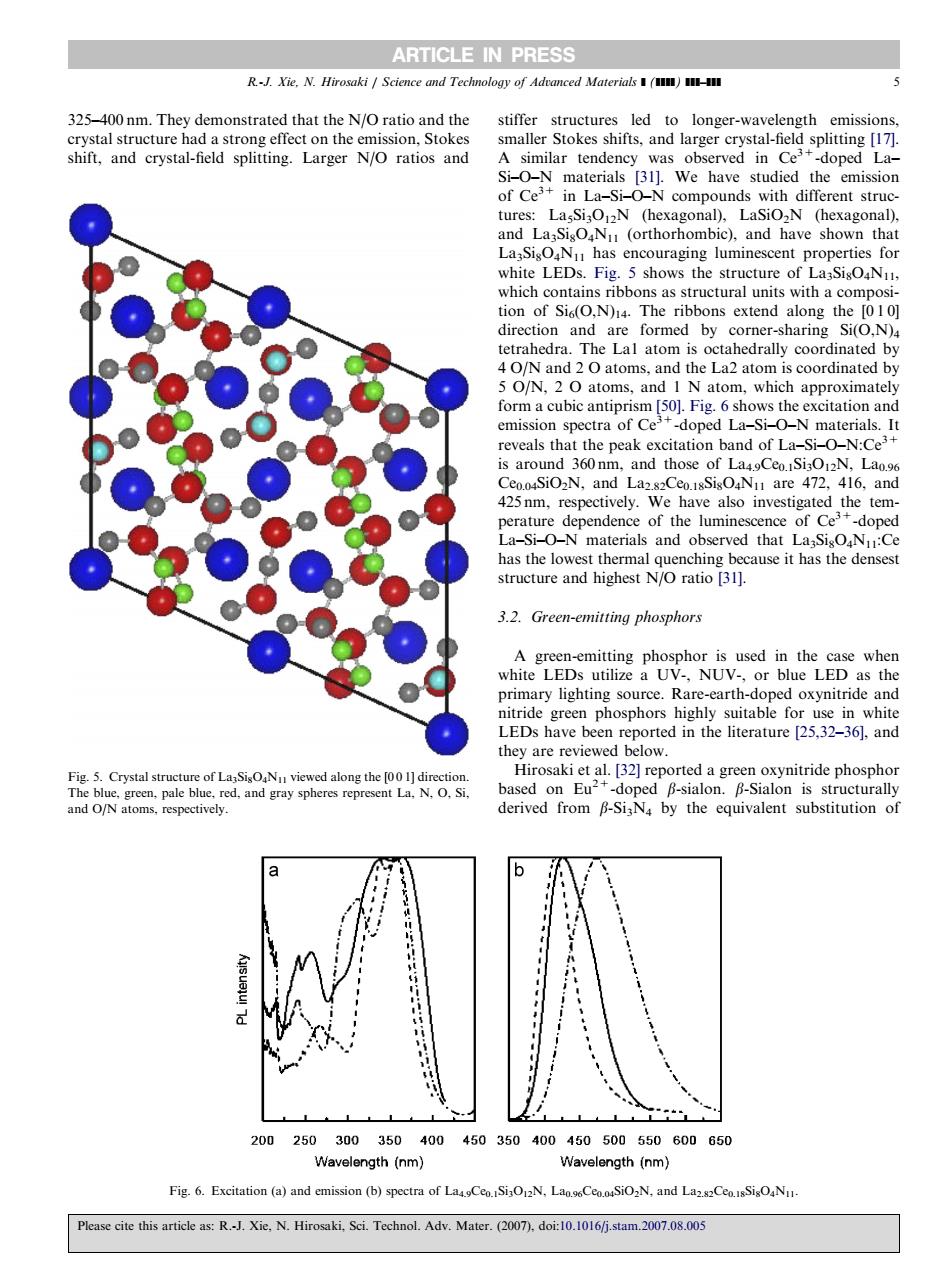正在加载图片...

ARTICLE IN PRESS 325-400 nm.They demonstrated that the N/O ratio and the stiffer structures led to longer-wavelength emission lope La- tures:LasSi,O12N (hexagonal).LaSiO2N (hexagonal) isN (orthorhombic),and have shown that encouraging tion of Si(O,N)4.The ribbons extend along the direction and are formed by ersharing ON) 5 O/N,2 O atoms,and I N atom,which approximately spectrao ad of Ia s around 360nm.and those of SiON.Laos nm,respectively. hav also investi 3.2.Green-emitting phosphors -NUV as the Lhave been od n thee 5and d on 6 200250300350400450350400460500550600650 Wavelength (nm) Wavelength (nm) Fig6.Excitation (a)and emission (b)ectra of,,and Pease cite this:R.Ki.N.Hiroki.Sci.Technol.Adv.Mater.().doi:0.0325–400 nm. They demonstrated that the N/O ratio and the crystal structure had a strong effect on the emission, Stokes shift, and crystal-field splitting. Larger N/O ratios and stiffer structures led to longer-wavelength emissions, smaller Stokes shifts, and larger crystal-field splitting [17]. A similar tendency was observed in Ce3+-doped La– Si–O–N materials [31]. We have studied the emission of Ce3+ in La–Si–O–N compounds with different structures: La5Si3O12N (hexagonal), LaSiO2N (hexagonal), and La3Si8O4N11 (orthorhombic), and have shown that La3Si8O4N11 has encouraging luminescent properties for white LEDs. Fig. 5 shows the structure of La3Si8O4N11, which contains ribbons as structural units with a composition of Si6(O,N)14. The ribbons extend along the [0 1 0] direction and are formed by corner-sharing Si(O,N)4 tetrahedra. The La1 atom is octahedrally coordinated by 4 O/N and 2 O atoms, and the La2 atom is coordinated by 5 O/N, 2 O atoms, and 1 N atom, which approximately form a cubic antiprism [50]. Fig. 6 shows the excitation and emission spectra of Ce3+-doped La–Si–O–N materials. It reveals that the peak excitation band of La–Si–O–N:Ce3+ is around 360 nm, and those of La4.9Ce0.1Si3O12N, La0.96 Ce0.04SiO2N, and La2.82Ce0.18Si8O4N11 are 472, 416, and 425 nm, respectively. We have also investigated the temperature dependence of the luminescence of Ce3+-doped La–Si–O–N materials and observed that La3Si8O4N11:Ce has the lowest thermal quenching because it has the densest structure and highest N/O ratio [31]. 3.2. Green-emitting phosphors A green-emitting phosphor is used in the case when white LEDs utilize a UV-, NUV-, or blue LED as the primary lighting source. Rare-earth-doped oxynitride and nitride green phosphors highly suitable for use in white LEDs have been reported in the literature [25,32–36], and they are reviewed below. Hirosaki et al. [32] reported a green oxynitride phosphor based on Eu2+-doped b-sialon. b-Sialon is structurally derived from b-Si3N4 by the equivalent substitution of ARTICLE IN PRESS Fig. 5. Crystal structure of La3Si8O4N11 viewed along the [0 0 1] direction. The blue, green, pale blue, red, and gray spheres represent La, N, O, Si, and O/N atoms, respectively. Fig. 6. Excitation (a) and emission (b) spectra of La4.9Ce0.1Si3O12N, La0.96Ce0.04SiO2N, and La2.82Ce0.18Si8O4N11. R.-J. Xie, N. Hirosaki / Science and Technology of Advanced Materials ] (]]]]) ]]]–]]] 5 Please cite this article as: R.-J. Xie, N. Hirosaki, Sci. Technol. Adv. Mater. (2007), doi:10.1016/j.stam.2007.08.005